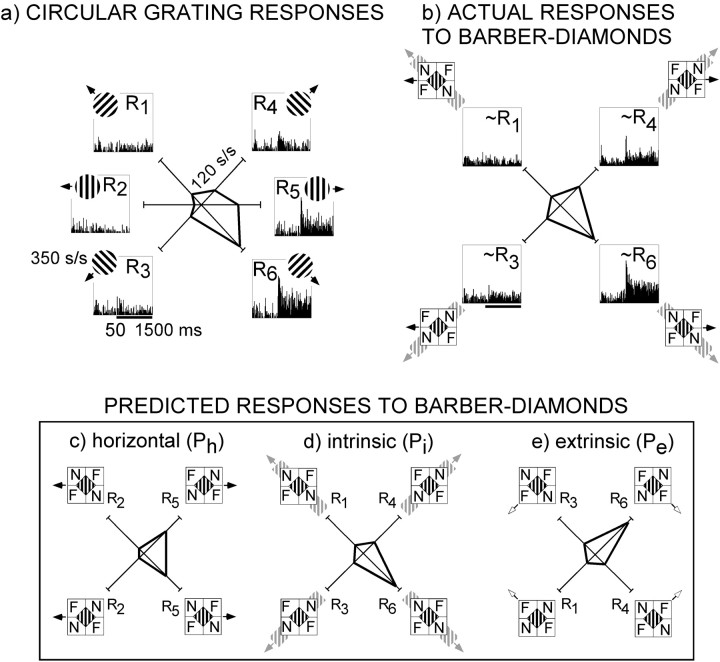Fig. 4.
Influence of depth ordering on direction selectivity of an MT neuron. The receptive field of this neuron was located 4° eccentric to the center of gaze and was 4.5° in diameter. a, Peristimulus time histograms (PSTHs) illustrate neuronal responses to circular gratings moved in each of six directions. Mean responses are indicated on the polar plot atcenter in which polar angle corresponds to direction of stimulus motion and radius corresponds to response amplitude in spikes per second. These responses (R1–R6) were used to form three different predictions for barber-diamond stimuli (c–e). b, Actual responses to barber-diamond stimuli. PSTHs for each of the four barber-diamond conditions are presented. The mean responses to moving barber diamonds are plotted in polar coordinates at center. Thebars under the bottom left histograms ina and b indicate the period of stimulus movement. c, Horizontal motion prediction (Ph). Icons illustrate the stimulus configuration for each of four experimental conditions. Predicted neuronal responses to each condition are shown on the polar plot atcenter. This prediction holds that neuronal responses will be influenced solely by the direction of grating motion (black arrows) and, hence, be of the same relative magnitude as responses to circular gratings moved leftward (R2) and rightward (R5), regardless of depth-ordering configuration. d, Intrinsic motion prediction (Pi). This prediction holds that responses will be associated with the direction of intrinsic terminator motion (gray arrows) and hence be of the same relative magnitude as responses to circular grating moving in the corresponding oblique directions (R1, R3, R4, and R6). e, Extrinsic motion prediction (Pe). This prediction holds that responses will be associated with the direction of extrinsic terminator motion (white arrows) and hence be of the same relative magnitude as the intrinsic motion prediction but flipped about the horizontal axis. Observed responses (b) of this neuron to barber-diamond stimuli (Ri‖h = 0.85) were more closely correlated with the intrinsic motion prediction than with either the horizontal or extrinsic motion prediction.

